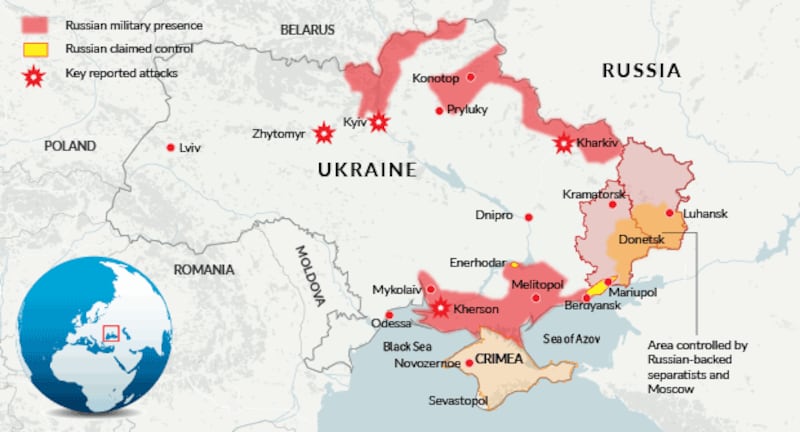The reported capture of Kherson, the strategic port city on the Dnipro delta, signals the success of Russia's steady march into southern Ukraine, while its troops in the north and east of the country have struggled to seize important targets.
Kherson, which became the first major city to fall as the invasion of Ukraine entered its second week, was taken by troops that entered the country from Russian-occupied Crimea – making strategic gains across the southern coastline and seeking to cut off Kyiv’s access to the Black Sea.
Kherson’s mayor has said Russian troops appeared to be in control of the city, confirming Russian claims. Ukraine is yet to confirm the loss of the city.
That success contrasts with the slow progress made by troops invading south from Belarus to encircle and capture the main target of Kyiv, and the failure to seize Kharkiv, where Ukrainian forces have held off waves of attack from troops who entered the east of the country from Russia.

Russia has continued to step up its deployment in Ukraine in recent days, with 82 per cent of its pre-assembled force of 150,000 troops now involved in the invasion.
"We haven't seen any indications that Mr Putin feels the need to bring in additional reinforcements from elsewhere in [Russia]," said John Kirby, Pentagon spokesman. "He began to build up this combat power starting in the early fall and has at his disposal more than 150,000 troops, more than 120 battalion tactical groups."
Proximity to Crimea
The Pentagon has said one reason Russia faced few obstacles in the south was because they had shorter supply lines because of the proximity to Crimea, the peninsula it annexed eight years ago. “They’ve been in Crimea since 2014, so they had already built up a pretty sophisticated and healthy architecture to support their operations,” Kirby said.
Russian forces have also encircled the south-eastern city of Mariupol from the east and west and are heavily shelling its centre, local officials said. The city is the last Ukrainian holdout preventing Russia securing a full land corridor from Crimea to territories that have been held by Kremlin-backed separatists since 2014.
Kherson's capture gives Russian troops a platform to move west towards Mykolaiv, western defence officials said, with an ultimate aim of capturing the major western port of Odesa, thus taking control of Ukraine's entire coastline. Russia has not yet made "any appreciable moves" on Odesa, officials said, but has stationed a naval frigate close by.
Apart from using ships to launch Kalibr cruise missiles in the initial bombardment that heralded the start of the invasion last Thursday, Moscow’s naval forces have so far played a limited role in the war.
Russia deployed 10 amphibious landing ships in the Black Sea before the invasion, but has only staged one small landing of naval troops, according to US and UK intelligence officials.
Moscow’s sizeable southern gains also provide a potential base to advance north along the Dnipro towards Kyiv, analysts and western officials said.
Russia has said that its troops have taken control of the territory around the Zaporizhzhia nuclear power plant, 200km up the Dnipro from Kherson. The International Atomic Energy Agency, the global nuclear watchdog, urged Russian troops to avoid nuclear sites and allow staff to continue working normally.
Russia’s gains in southern Ukraine come as its troops struggle to break Ukraine’s defences around Kharkiv and Kyiv. Kharkiv, the country’s second-largest city, has been barraged by rocket, missile and artillery strikes in recent days.
At the same time, widespread logistical and supply issues have impeded a large Russian convoy of troops, tanks and weapons intended to encircle and attack Kyiv, western officials said.
“They have lost a sense of momentum here, but that doesn’t mean that they still don’t have the power at their disposal,” said Kirby. – Copyright The Financial Times Limited 2022














